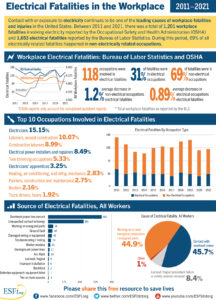Understanding & Preventing Workplace Electrical Fatalities
By Daniel Majano and Brianne Deerwester, Contributors
Each year, the Electrical Safety Foundation International (ESFI) collects information on fatal occupational electrical injuries using the U.S. Bureau of Labor Statistics (BLS) Census of Fatal Occupational Injuries (CFOI), Survey of Occupational Injuries (SOII), and the Occupational Safety and Health Administration’s (OSHA) Fatality and Catastrophe Investigation Summaries. ESFI’s objective is to understand and communicate the underlying cause of workplace electrical fatalities. The organization publishes this information on esfi.org in tabular and graphical form. Nonfatal occupational injuries previously were reported every year but are now reported every other year by OSHA and the BLS.
To better promote electrical safety in the workplace, ESFI provides this yearly statistical data report that helps decision-makers better allocate safety resources for maximum impact. This work builds on earlier work by the National Institute for Occupational Safety and Health (NIOSH), providing new information on electrical incidents as it becomes available.
The data in our reports cover U.S. occupational electrical accidents, the occupations in which they occurred, and the source of the injury. Each fatal injury is verified by two or more independent sources of information. Such sources can include death certificates, police reports, news reports, or OSHA reports. ESFI compiles the data to track electrical injury trends and to identify occupations and industries where electrical training – provided by the NIOSH, OSHA, and ESFI – can be applied to reduce the number of occupational electrical injuries.
Fatal Electrical Injuries between 2011 and 2021
Contact with or exposure to electricity continues to be one of the leading causes of workplace fatalities and injuries in the United States. Between 2011 and 2021, there was a total of 1,201 workplace fatalities involving electricity reported by OSHA and 1,653 electrical fatalities reported by the BLS. OSHA reports are screened to remove personal information about the victims, which causes a delay in reporting and results in a difference in the number of incidents when compared to the BLS.
During the same timeframe, 118 occupations were involved in electrical fatalities. Throughout this period, electrically related occupations accounted for 31% of these incidents, while 69% of all fatalities happened in non-electrically related occupations. Overall, there was a 1.2% average decrease in non-electrical occupation electrical fatalities and a 0.89% average decrease in electrical occupation electrical fatalities.
The Top 3 occupations involved in electrical fatalities included electricians with 15.15% of all fatalities, non-construction laborers with 10.07%, and construction laborers with 8.99%. The rest of the Top 10 occupations involved in electrical fatalities included electrical power installers and repairers with 8.49%, tree trimming occupations with 5.33%, electricians’ apprentices with 3.25%, heating, air conditioning, and refrigeration mechanics with 2.83%, painters, construction, and maintenance with 2.75%, roofers with 2.16%, and truck drivers, heavy with 1.92%.
The Top 3 sources of electrical fatalities for all workers included overhead power line contact with 582 fatalities, unexpected contact with energy with 385 fatalities, and working on energized parts with 55 fatalities. The remaining top sources of electrical fatalities included ground faults with 46 fatalities, damaged wiring or equipment with 41 fatalities, troubleshooting/testing with 29 fatalities, worker mistakes with 21 fatalities, underground power lines with 11 fatalities, arc-flash with 10 fatalities, lockout/tagout failure with 9 fatalities, improper installation with 4 fatalities, backfeed with 2 fatalities, defective equipment/equipment failed with 1 fatality, and two or more sources with 4 fatalities.
The cause of electrical fatalities for all workers included contact with overhead power lines at 45.7% of all incidents, working on or near energized conductors/energized parts at 44.9%, lockout/tagout procedure failure or safety controls removed at 8.4%, and other sources with 1%.
Avoiding Future Accidents
Overhead power lines continue to be one of the leading causes of workplace electrical fatalities. Being aware of where overhead power lines are located and carrying equipment horizontally to avoid bumping into any power lines can make a major difference in saving lives.
Further, accidental contact with energized conductors or parts are another leading cause of fatalities. Seventy-four percent of these fatalities from 2011 to 2021 occurred in electrical occupations. Always test for voltage before you perform work. Be sure to also test the area around the equipment you are working on to avoid accidental contact with energized equipment. If workers are conducting work around electricity, then they need to be properly trained to do so safely. Even occupations that aren’t traditionally trained about electrical safety practices on the jobsite should be if electrical hazards will be present.
Establishing a culture of safety in your workplace is imperative to keeping workers safe and preventing avoidable accidents on the jobsite. Challenge your workers to take charge of their safety and to take the necessary steps to avoid electrical hazards, even if it requires more time to do so. Knowing when to say when can save your life and the lives of those working with you. If you ever feel unsafe performing a job, say something. It’s okay to pass a job task to a more qualified worker if you’re unsure you can complete the task safely.
By taking the above actions, always performing a site and risk assessment, avoiding complacency, and following the hierarchy of controls, you can keep yourself and others safe on the jobsite.
For more information and to utilize ESFI’s free-to-share workplace safety materials throughout your community, visit esfi.org.
Daniel Majano is Program Manager, Electrical Safety Foundation International (esfi.org).
Brianne Deerwester is Communications Coordinator, Electrical Safety Foundation International (esfi.org).




